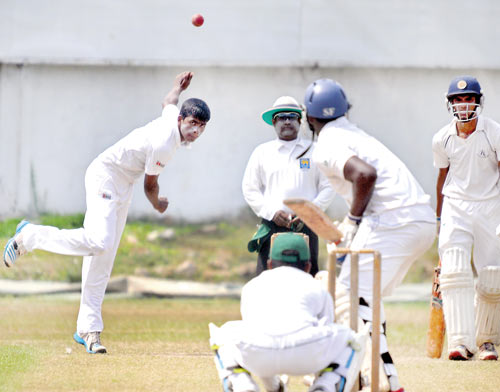Underpaid cricketers and good old wine
View(s):Old wine in a new-fangled package, but with an old label, was put out by Sri Lanka Cricket on Tuesday. Though our explanation reads a bit tongue-in-cheek, but, seriously the new committee sees cricket in its right perspective and is trying to address some of the issues that should have been served on the table, long before.

How could the main system run a Provincial Tournament without a proper system in place - File pic
Anyone who is genuinely into the game of cricket in Sri Lanka is aware that the gap between the local club cricket and the international cricket keeps widening by the minute. Not that the situation went unnoticed by the cricket think-tank of this country; they tried and are still trying, but, besides a few damp plasters which are hanging at one end, the system has not been able to resolve the issue professionally.
Some time ago, some of the biggest cricketing brains in this country saw the provincial cricket system as the messiah and included it in the agenda. Alas, provincial cricket came in and was played for a few years, but, it was not taken seriously because the base structure of the tournament had no solidity. For instance, a player born in Galle sometimes represented the Central Province. Besides, some of the players also kept on rotating from tournament to tournament.
Those who backed the provincial cricket system saw this and a few years ago the now cricket committee member Michael Tissera developed a provincial cricket blue print which was plausible and the then governing system began to move it.
It was at this point that the stakeholders – the vote base of cricket — saw the provincial cricket movement as a threat and began to move against it. By last year, the provincial tournament had lost its identity and title while being relegated to a T-20 tournament which came in place for the aborted SLPL tournament.
Through the years, the cricket brains have tried to have that special niche in cricket — the tournament where the national cricketers and the others who tap on the door could compete on even keel. It came in various shapes and names, but the ultimate goal was the same. Once it came in the guise of the Robert Senanayake trophy, and then as the Super Tournament and then the Provincial Tournament, to name a few. Nevertheless it is the Provincial Tournament which has had the nine lives and still is refusing to declare its inning.
It’s good that the provincial cricketers would get an enhanced payment — more than the increased payment proposed for Premier League cricketers. Yes, this would go a long way, as cricket with more in the pocket would always interest players especially if their present contracts are taken off them.
However, the question is: How could the system run a provincial tournament without a system in place? More than once, they have failed in that endeavour. Unlike in India, Australia or in South Africa, we have no structure in place outside Colombo — or Galle and Kandy to a lesser extent. As a result if a provincial cricket tournament is put on course, the system will once again select the players in the same ad-hoc manner where no  cricketer will have a sense of belonging. This means the tournament would run as long as somebody wants it, but it would never grow in its base, even if the enhanced payments are attractive to the players.
cricketer will have a sense of belonging. This means the tournament would run as long as somebody wants it, but it would never grow in its base, even if the enhanced payments are attractive to the players.
The payment to the players was also in another jug. We remember former secretary Nishantha Ranatunga going on with an argument. He always claimed that out of the monies that Sri Lanka earns as a cricketing nation 70 per cent is taken by the 100 or so players – monies given for the contracts and cricket sustenance. However, of this money that is spent for the cricketers, as much as 80 per cent went towards the contract payment of the top twenty five players, who earns on an average Rs. 80 million a year.
This still looks a colossal amount, but the justification depends upon their rate of success, but, still the percentage is huge.
But, our concern at this end is about the players who stand to lose their contracts. I am sure with such a large amount of money going to less than thirty players – the new count of contracted players is not going to be big. We have walked about the Premadasa facility on numerous occasions and we know how the machine works there.
It is a stubborn truth that more than 70 per cent of the new cricketers who join the national grid now come from the outstation, in spite of our junior cricket system has almost gone beyond repair. If one cares to take a head count of the lads who are going to lose their contracts, they would be the lads who have come to Colombo seeking a new life through cricket.
Just imagine, without a contract, how a new Nuwan Pradeep could sustain himself in Colombo. With the increased payment of Rs. 7,500 a day he stands to make Rs. 30,000 a match and for a season and hypothetically if he plays fifteen such matches he would make Rs. 450,000 a year. This would work to about Rs. 37,500 a month. These are the guys who slept inside scoreboards and club houses even with a contract. Sometimes they are the bread winners of their families. Without sufficient cash to sustain themselves in the game, we may lose a few Malingas to manual labour.
Not that the earlier system was good. At that point it was a case of the scorers and the umpires earning a bigger daily pay than the players who really play the game.
There is another school of thought. Their argument is: anyhow there would be the senior national squad and the ‘A’ squad — playing their cricket under Marvan Atapattu and Romesh Kaluwitharana. Besides, there also will be the Development Squad that would do their training under Sumithra Warnakulasuriya the entire total working towards 40-55 players. In all probabilities the contracts will stop here.
They see this as a manageable number, taking the facilities that we do possess at the R. Premadasa Stadium, the centre where even the national squad does their training.
But, they also feel that the governing body should take a more serious count on how the cricketers are going to survive being professional cricketers in Sri Lanka. They feel that the management should work backwards and see how many playing days that a cricketer would be involved in a year and work out his payment based on that. The argument is even an average club cricketer who is playing first class cricket is entitled to lead a normal respectable life. They may play the game for only six months, but to sustain themselves in a competitive level they would have to keep training even during the cricketing winter.
The good news is that the cricket’s governing body is hoping to have more such facilities in Pallekelle, Sooriyawewa and Dambulla. Great. If these outer hubs become a reality the lads from the area could be in the game as they would have the access to these places unlike travelling all the way to Colombo. Once in Colombo it is not very easy for them to survive, too. But, until such time those facilities become a reality, Sidath Wettimuny and company could think of a way of sustaining these guys in the game of cricket and not luring them out of it.
PS: Good to teach them etiquette, manners and English and moreover handling the marauding media, yet to do that the village lad has to remain in cricket. Sons of the dons would always be trained at home or by the Toastmasters.


